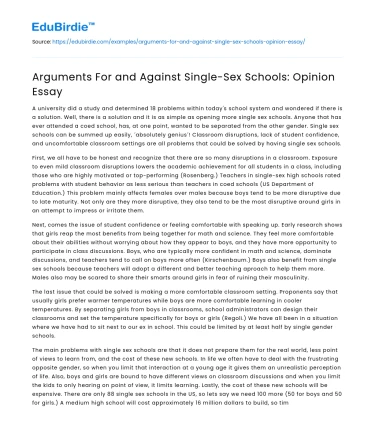A university did a study and determined 18 problems within today's school system and wondered if there is a solution. Well, there is a solution and it is as simple as opening more single sex schools. Anyone that has ever attended a coed school, has, at one point, wanted to be separated from the other gender. Single sex schools can be summed up easily, ´absolutely genius´! Classroom disruptions, lack of student confidence, and uncomfortable classroom settings are all problems that could be solved by having single sex schools.
First, we all have to be honest and recognize that there are so many disruptions in a classroom. Exposure to even mild classroom disruptions lowers the academic achievement for all students in a class, including those who are highly motivated or top-performing (Rosenberg.) Teachers in single-sex high schools rated problems with student behavior as less serious than teachers in coed schools (US Department of Education.) This problem mainly affects females over males because boys tend to be more disruptive due to late maturity. Not only are they more disruptive, they also tend to be the most disruptive around girls in an attempt to impress or irritate them.
Save your time!
We can take care of your essay
- Proper editing and formatting
- Free revision, title page, and bibliography
- Flexible prices and money-back guarantee
Next, comes the issue of student confidence or feeling comfortable with speaking up. Early research shows that girls reap the most benefits from being together for math and science. They feel more comfortable about their abilities without worrying about how they appear to boys, and they have more opportunity to participate in class discussions. Boys, who are typically more confident in math and science, dominate discussions, and teachers tend to call on boys more often (Kirschenbaum.) Boys also benefit from single sex schools because teachers will adopt a different and better teaching aproach to help them more. Males also may be scared to share their smarts around girls in fear of ruining their masculinity.
The last issue that could be solved is making a more comfortable classroom setting. Proponents say that usually girls prefer warmer temperatures while boys are more comfortable learning in cooler temperatures. By separating girls from boys in classrooms, school administrators can design their classrooms and set the temperature specifically for boys or girls (Regoli.) We have all been in a situation where we have had to sit next to our ex in school. This could be limited by at least half by single gender schools.
The main problems with single sex schools are that it does not prepare them for the real world, less point of views to learn from, and the cost of these new schools. In life we often have to deal with the frustrating opposite gender, so when you limit that interaction at a young age it gives them an unrealistic perception of life. Also, boys and girls are bound to have different views on classroom discussions and when you limit the kids to only hearing on point of view, it limits learning. Lastly, the cost of these new schools will be expensive. There are only 88 single sex schools in the US, so lets say we need 100 more (50 for boys and 50 for girls.) A medium high school will cost approximately 16 million dollars to build, so times that by one hundred and the cost would be one billion six hundred million. There is no way of knowing where we could get that money.
So it is obvious that several problems including classroom disruptions, lack of student confidence, and uncomfortable classroom settings, could be solved. The solution is quite simple honestly. Offer students the option of attending single sex schools.
Works Cited
- Robert Kirschenbaum 2002-2019 National Education Association http://www.nea.org/archive/17276.htm
- Natalie Regoli 2019 https://greengarageblog.org/author/greengarageblogadmin
- Rhonda Rosenberg November 3, 2016 https://www.uft.org/news/teaching/how-class-disruptions-affect-achievement
- U.S. Department of Education 08/11/2009 https://www2.ed.gov/rschstat/eval/other/single-sex/characteristics/index.html






 Stuck on your essay?
Stuck on your essay?

